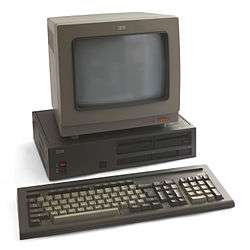IBM JX
The IBM JX (or JXPC) was a personal computer released in 1984 into the Japanese, Australian and New Zealand markets. Designed in Japan, it was based on the technology of the IBM PCjr and was designated the IBM 5511. It was targeted in the Australasian market towards the public education sector rather than at consumers, and was sold in three levels: JX (64 KiB), JX2 (128 KiB) and JX3 (256 KiB). Upgrades were available to both 384 KiB and 512 KiB. The JX was the first IBM PC to use 3.5" floppy drives.[2]
 | |
 IBM JX Personal Computer (IBM 5511) | |
| Developer | IBM |
|---|---|
| Release date | October 1984 |
| Discontinued | 1987[1] |
| Units shipped | 40,000[1] |
| Operating system | PC DOS 2.1, Microsoft Disk BASIC, Advanced BASIC |
| CPU | Intel 8088 @ 4.77 MHz |
IBM Japan expected to sell 200,000 units of JX, but only 40,000 units were produced. The JX was discontinued in 1987, and IBM Japan gave 15,000 units of JX to its employees in honor of company's 50th anniversary.[1]
General
The IBM JX's main difference from the PCjr was a professional keyboard (rather than the PCjr's disparaged chiclet keyboard), dual 3.5" floppy drives, as well as options for a 5.25" floppy drive and a hard drive, both of which sat atop the main unit. The JX did not support PCjr-like "sidecar" add-ons for hardware expansion. In common with the PCjr, however, it had no DMA controller. It also supported the otherwise unique-in-the-IBM-PC-world ECGA (Enhanced Color Graphics Adapter—16 simultaneous colors, but only at 320×200 resolution) and the PCjr's 4-channel sound. Support for these two features was utilised by only a handful of software developers—Sierra On-line being the most well-known.
Configuration
It had several innovative features:
- Single or twin 3.5" 720 KB (initially only 360 KB) diskette drives
- Wireless infra-red keyboard[3]
- 16-color video output
- Stackable expansion
- Joystick ports[3]
- Cartridge slots[3]
In Japan, both white and dark gray units were available,[3] but elsewhere all IBM JXs were dark gray—very unusual in the days of the standard color of IBM "beige boxes".
However, one disadvantage it shared with the PCjr was that it could not use the standard ISA bus cards of the IBM PC.[3]
The system operated PC DOS 2.11 as well as Microsoft Disk BASIC and Microsoft Advanced BASIC. Like the PC, if the system was left to boot without inserting a diskette into one of the drives the Microsoft Cassette BASIC interpreter would be loaded, which was compatible with IBM PCjr BASIC, including Cartridge BASIC. PC DOS 2.11 could only use half of the tracks of a 3.5" drive, however, since it didn't really understand what a 3.5" drive even was. The PCjx's BIOS could only address the first 40 tracks, like a 5.25" drive.
The PCjx later had a BIOS upgrade chip, sold together with PC DOS 3.21, which could use the full 720 KB capacity of the diskette drives. Some popular options for the PCjx were a 5.25" 360 KB capacity diskette drive, a 10 MB external hard disk (both of these as stackable units the same size as the JX itself) and a joystick. IBM never released a 3270 emulation adapter for the PCjx, in order to steer enterprise customers to more-expensive IBM PCs and XTs.
Reception
BYTE in 1985 called the JX "a Japanese product for the Japanese; its price and capabilities reflect its target market". The magazine stated that its compatibility with PCjr peripherals rather than the PC's, and joystick ports and audio, "suggests that IBM Japan is hedging its bets by pursuing a share of the easily saturated video-game sector". BYTE concluded that "the JX will enjoy, at best, a modest and short-lived success—it's too little, too late" against more-sophisticated rival computers.[3]
References
- 木崎, 健太郎 (1987-09-14). "コンピュータ・アイ:パソコンかコーヒー・カップ、あなたならどちらを選ぶ?". 日経コンピュータ (in Japanese). Nikkei McGraw-Hill: 122–123. ISSN 0285-4619.
- Dunn, Ron (December 1985). "IBM JX Benchtest". Personal Computer World. Retrieved 4 June 2020.
- Raike, William M. (March 1985). "A Sampler". BYTE. p. 375. Retrieved 19 March 2016.
External links
- IBM JX, The As-Yet Unnamed Computer Museum!!
- IBM JX Information Page, IBM JX Information Page
- IBM PC JX, OLD-COMPUTERS.COM Museum
- 1984 (month unknown), Chronology of IBM Personal Computers (1983-1986), archive from the original on March 15, 2012.
- Photo:Vintage IBM 5511
- Japanese IBM JX commercial on YouTube
- Australian IBM JX commercial on YouTube
- Photo:IBM JX joystick